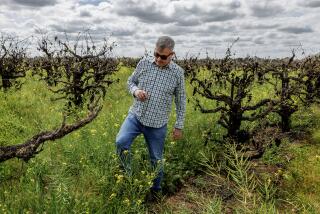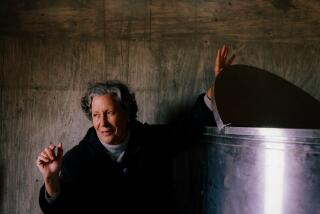Where Malbec’s on the rise
Mendoza, Argentina — MATiAS MAYOL slowly pours a bottle of his family’s Malbec wine into a 3-foot-deep hole in the backyard of his cousin’s Mendoza, Argentina, home and silently prays: Pachamama, you have blessed Argentina with four great Malbec harvests in a row. How about five for five?
Mayol’s Italian-Argentine family subscribes to the ancient Incan belief that, if you take care of Mother Earth -- Pachamama -- she’ll take care of you. So, following the wine, a potful of pumpkin and hominy stew, several still-steaming empanadas and handfuls of olives from the family’s trees go into the hole as offerings to the goddess.
The old lady must like Malbec. Mendoza, Argentina’s premier wine region, has been blessed with year after year of textbook-perfect vineyard weather. The red wines, particularly the Malbecs, from 2005 may be Argentina’s best vintage ever.
For Mayol, as for many other Argentine vintners, the good fortune is timely. He’s part of a recent boom that means new wineries and improved viticulture dedicated to making world-class wines. Today, he can take full advantage of Pachamama’s largesse.
Argentine wine is coming of age, says James Wolpert, chairman of viticulture and enology at UC Davis. And the potential for continued improvement is a little frightening to the rest of the winemaking world. “It’s Argentina’s turn to knock us out of our chairs,” he says. “And they are doing it with a grape that no one’s ever done it with before.”
Malbec, the dominant grape grown in Argentina, has become its signature wine grape. Originally a minor Bordeaux blending grape, Malbec is ignored everywhere else in the world except in Cahors, France, where the varietal is a regional table wine.
*
Malbec mystery
HOW Malbec evolved into such a charmer in Argentina remains a bit of an enological mystery. The clues lie in a combination of terroir, Darwinian selection and the influence of international consultants bent on modernizing a calcified wine industry.
“Something strange happened to Malbec in the soils and climate of Argentina. It mutated,” says Steve Clifton, a Santa Ynez Valley winemaker whose Palmina and Brewer-Clifton wines have made him one of that region’s tastemakers. Clifton, who along with Joe Bastianich (co-owner with Mario Batali of several restaurants in New York and wineries in Italy) has partnered with Mayol, is one of a handful of outsiders staking a claim in Mendoza. “It’s all about the climate,” says Clifton.
Visiting Mendoza in the dead of winter -- August in the Southern Hemisphere -- is like a trip to the surface of the moon. It’s cold, with temperatures dipping below freezing. The vines, stripped of their leaves, are skinny twigs sticking up out of the rocky, gray desert soils. Even the oldest plants look undernourished.
In the spring, salvation comes from the towering, snow-capped Andes stretching along the western horizon. The snowmelt flows down to the desert following ancient trench lines first laid out by the Incas. When February’s late-summer sun threatens to bake the vineyards, afternoon breezes rush down from the mountains to cool the grapes, saving them from becoming raisins before harvest in March and April.
Half of Mayol’s vineyards are covered with 81-year-old vines. The other half were planted nine years ago. It’s a common equation in a region that has been producing wines for hundreds of years and, of late, has experienced a renaissance.
Once a prolific producer of plonk, Argentina has spent the last decade overhauling its wine industry with the help of such foreign experts as Sonoma vintner Paul Hobbs, French enologist Michel Rolland and Italian winemaker Alberto Antonini. Out with the concrete vats from 1930 and in with stainless steel fermentation. Most of Argentina’s wine is consumed by locals, but the more ambitious vintners are focused on exporting to the United States.
Argentine Malbec delivers a mouthful of wine, plenty of fruit on top of a sensuous, smooth structure, Hobbs says. He brought modern winemaking to Argentina 15 years ago when Nicolas Catena hired him to overhaul Catena Zapata. Now, with Vina Cobos, Hobbs has his own operation in Argentina and makes some of the most celebrated wines in the region.
“It’s not as massively tannic as Cabernet Sauvignon, which has to be paired with a big chunk of protein,” he says. “Malbec can handle a steak, but I like it because it does well with fish and even spicy food.”
It isn’t what you expect from a big, ripe New World wine. There is a spectrum of flavors stretching from masculine gaminess to delicate florals. Paul Hobbs crafts rich, intense wines that fill the mouth with the flavor of ripe black cherries. Susana Balbo and Pedro Marchevsky of Dominio del Plata produce Malbecs with flavors of bacon, tobacco and leather. Another internationally acclaimed winery, Achaval-Ferrer, cultivates old Malbec vines to make floral wines with sweet violet notes. The deep-purple wines Clifton makes with Mayol have heady aromas of lavender and fine herbs.
In Malbec’s ancestral home in Bordeaux, however, the grape is a bit of a dud, producing thin wines with little character and less appeal. Its only following is in Cahors, where it is an inky full-bodied wine. Malbec fell out of favor in France 100 years ago, says Rolland, an enologist who has been consulting with several Argentine vintners, but now is focused solely on his own project here, Clos de los Siete. “Everyone knows Argentina is the right place for Malbec. Why try to develop it elsewhere?”
*
Such different grapes
IT’S not just terroir. Jose Galante, the winemaker for Catena Zapata, the Argentine winery with the largest volume of sales in the U.S., has grown the French vines in Mendoza. Although they were the same variety as his Argentine vines, grapes from the French and Argentine plants, he says, were nothing alike. Argentine Malbec grapes were small and intense, with a deep-purple color. The grapes from the French vines? “We could have played basketball with them, they were so big and fat, no flavor at all.”
How could vines of the same variety produce such different grapes? The best guess, according to UC Davis’ Wolpert, is that the sunny, arid climate and thin soils of Mendoza are optimal for the particular Malbec clone that has evolved there since the grape was introduced in the early 1800s. The clone is probably unique to Argentina: The phylloxera blight that nearly wiped out French vineyards in the 1860s didn’t touch vineyards in Argentina. “South America may have Malbec clones that are no longer in existence in France,” Wolpert says.
In Argentina today, everything is riding on Malbec. But the wine was not always well-understood, or cherished. In the 1980s, vintners destroyed two-thirds of their Malbec vineyards when over-production threatened to swamp the industry, says Diego Bigongiari, editorial director of the Austral Spectator, South America’s premier winery directory.
“We went from 40,000 hectares to 15,000 hectares of Malbec vineyards by the 1990s,” he says. Now that the wine is taking off worldwide, it is being planted again, he says.
Malbec is too enticing of a wine to just leave it for Argentina, says Wolpert. Winemakers in California are starting to be interested in the grape, but no one knows how Malbec will behave there because there has been so little experimentation. UC Davis only recently started a comparative study of Argentine and French Malbec vines.
The interest is fueled by economics, of course. Sales of Argentine Malbec in the U.S. are picking up. In 2002, a modest $6.6 million worth of Malbec wine was sold here. By 2004, sales had more than doubled. And, for the first half of this year, sales reached $11.5 million, nearly twice last year’s sales for that period, according to TGIC Importers, a Woodland Hills-based wine distributor specializing in Argentine and Chilean wines.
In Hobbs’ view, it’s time that the best Argentine Malbecs be priced on par with other great wines of the world. His least expensive Malbec, El Felino, was $13 a bottle for the 2003 vintage. He’s priced the 2004 vintage at $25. The price of his Bramare has doubled to $85, and his signature Cobos Malbec is $150, possibly the most expensive Argentine wine on the market.
Mayol and Clifton are less sure of themselves, pricing their best 2004 wine at a more modest $30 on release later this year. But, Pachamama permitting, they believe the race to make the best Malbec has just begun.
More to Read
Eat your way across L.A.
Get our weekly Tasting Notes newsletter for reviews, news and more.
You may occasionally receive promotional content from the Los Angeles Times.









